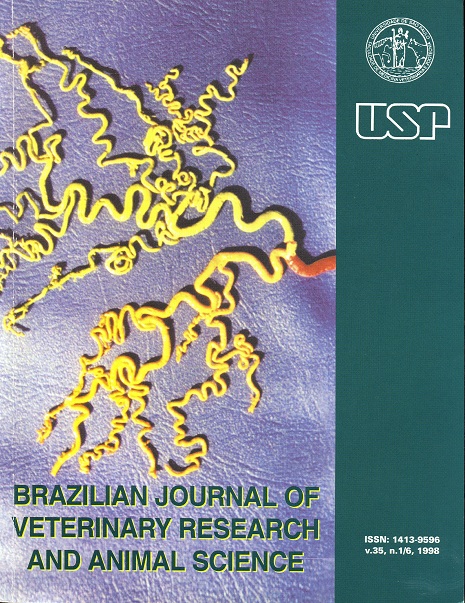Compared study on the effects of mechanical controled ventilation (MCV) with or without the use of positive-end-expiratory-pressure (PEEP) on inter-pleural pressure variation in horse anesthesia
DOI:
https://doi.org/10.1590/S1413-95961998000600006Keywords:
Anesthesia, Artificial respiration, EquineAbstract
One of the main death causes in equines during anesthesia and recovery periods is hipoxemia due to intrapulmonary "shunts". In human beings, hipoxy is treated with the use of Positive-End- Expiratory Pressure (PEEP), that in this species hinders airway closure, increases functional residual capacity and improves arterial oxygenation. We studied the effects of PEEP on inter-pleural pressure and on the cardio-vascular system, comparing Spontaneous Ventilation (SV), with Controlled Mechanical Ventilation (CMV) by itself and with PEEP of 10 cm H2O. We used 12 adult horses, females and males. These animals were submitted to general anesthesia with SV, CMV and CMV with PEEP of 10 cm H2O. The anesthetic procedure was equal for all horses. The hemodynamic, ventilatory and oxygenation parameters were evaluated. The statistical analysis of the results showed that when comparing SV, CMV and CMV with PEEP, there was no significant decrease in arterial blood pressure, nor significant alterations in cardiac and respiratory rate, pH, HCO3, BE and SatHb. When comparing SV, and CMV, an increase in PaO2 was noticed, parallel to a constant increase in PaCO2. No significant alterations in "shunt", alveolar-arterial relation and oxygen contend, were noticed. However during CMV and CMV with PEEP lower "shunt" values were noticed. Inter-pleural pressure showed significant alterations, decreasing during CMV and with CMV with PEEP, in comparison to VE. We concluded that CMV and CMV with PEEP of 10 cm H2O do not harm the cardio-respiratory system.Downloads
Download data is not yet available.
Downloads
Published
1998-01-01
Issue
Section
VETERINARY MEDICINE
License
The journal content is authorized under the Creative Commons BY-NC-SA license (summary of the license: https://
How to Cite
1.
Klemm M, Alvarenga J, Fantoni DT, Silva LCLC, Auler JO. Compared study on the effects of mechanical controled ventilation (MCV) with or without the use of positive-end-expiratory-pressure (PEEP) on inter-pleural pressure variation in horse anesthesia. Braz. J. Vet. Res. Anim. Sci. [Internet]. 1998 Jan. 1 [cited 2024 Apr. 23];35(6):260-5. Available from: https://www.revistas.usp.br/bjvras/article/view/5677





